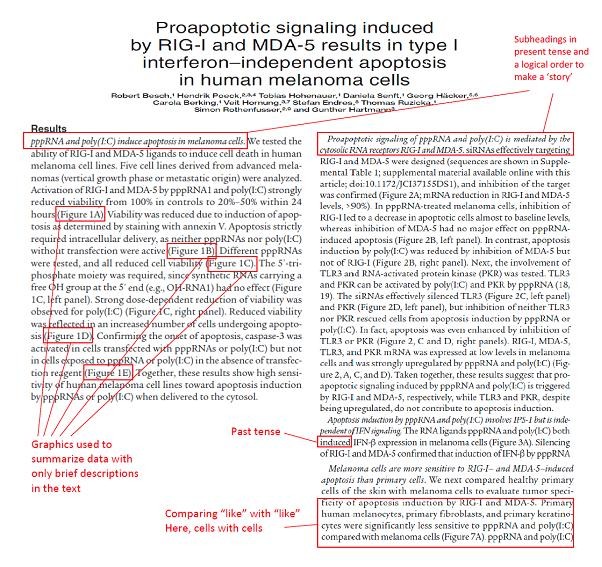博文
结果,你发现了什么
|

“结果”可能是论文最重要的部分。在这部分你要叙述主要的研究结果,读者想知道的也就是这些。而且,研究结果还影响到”引言”和”讨论”部分的编排,目标期刊的选择和以及后续研究的方向。
在开始撰写“结果”之前,你应全盘考虑你的试验发现,并审视他们到底意味/提示什么。此时你应该已经完成了数据分析,并已制作了几幅图表以便简单明了地展示结果。后文将有一些图表制作和统计分析方面的注意事项,所以这里就暂不赘述。不过,一定要记得:图是“结果”的重要组成部分,所以图、表、正文之间不能有重复的叙述。简而言之,如果用图表比用文字表达得更清楚,就用图来表达,然后在正文中简单提及;如果用文字就可以简单阐明,就无需再用图来表达。
一旦确定要把哪些结果纳入正文以及这些结果的意义,,你就可以把它们按一个符合逻辑的顺序组合成一个“故事”。在“引言”部分已经说明了假设或拟研究的问题;现在,在“结果”部分展示你收集的全部证据,用于支持你的假设或排除其他备择解释。用现在时态的子标题把每种不同的结果分成单独的小节。这些子标题应该与“方法”部分的子标题以及图表的标题相互对应。与“方法”部分一样,叙述“结果”时应使用过去时。你用于支持假设的证据种类越多(以及越不含混),你的结论就越无可置疑。这里暂时不要去讨论你结果的影响或大谈其意义—那是“讨论”部分的任务。这里只用展示你的证据,然后留待读者自行去下结论。
“结果”部分经常需要比较样本和对照,或者比较某个时间点前后的结果,所以有必要了解陈述比较时一些常犯错误。其中一些也包括在“克服语言障碍”一章的注意事项中。最重要的是“同类事物间才能做比较”。例如,有这样一个句子:“Expression levels of p53 in smokerswere compared with non-smokers” 就应该改成“Expression levels of p53 insmokers were compared with those in non-smokers”。这里的一个关键是“werecompared” 这个短语(其他句子中也可能是 “compared with”)的位置。如果这个短语位于被比较双方(如此例中:吸烟者的p53 levels 和 不吸烟者的p53levels)之间,那么比较的双方都必须要有足够的信息来清楚界定到底比较的是什么。也可以把这个短语放在被比较双方之前或之后,例如:“Expression levels of p53 in smokers and non-smokers werecompared”。叙述比较的另一个问题是,比较性的词语如“more”,“higher”和“faster”等,后面需要跟一个”than”开始的从句来解释是比谁多、高或者快。比如,“transgenic mice showedhigher levels of cortisol”这个句子中是比谁高就不明确,因此应该加上“than control mice”。
示例
下图节选自《The Journal of Clinical Investigation》上一篇论文的“结果”部分(doi:10.1172/JCI37155;经同意转载)。其中显示了“结果”部分的一些要素。
核对清单
1. 你的数据如果用图表更容易表达就用图表;反之用文字。
2. 使用过去时叙述结果。
3. 同类事物才能做比较。
4. 图、表、正文内容不能重复。
5. 正文中说明统计分析结果,如P值。
英文原文
Results: what you found
Theresults section is possibly the most important section in your paper.In this section you will describe the main findings of your research,which is what everyone who is going to read your paper wants to knowabout. Also, whatever findings you obtained will determine how theintroduction and discussion sections are framed, what target journalsyou can consider, and what direction(s) your subsequent research needsto take.
The easiest way to approach writing a results sectionis to consider all of your findings and what they mean or suggest. Youwill already have analyzed your data and probably also generated anumber of figures and/or tables to show it in a clear and concisemanner. Later tips in this series describe some importantconsiderations to keep in mind when preparing display items andperforming statistical analyses, so I won’t go into much detail onthose processes here. However, it is important to remember thatgraphics are important components of the results section, andtherefore, that there should be no redundancies or duplications amongthe text, figures and tables. Put simply, if something can be moreclearly shown in a figure or table than explained in the text, then usea graphic and refer to it briefly in the text; if something can beeasily summarized with text, then there is no need for an additionalgraphic showing the same thing.
Once you have a clear idea ofwhat results you want to include and what each of them shows, youshould assemble them in a logical order to make a ‘story’. You willhave already described your hypothesis or research question(s) in theintroduction; use the results section to lay out all of the evidenceyou have gathered, building up a solid case to support your hypothesisor to exclude alternative explanations. Each different finding shouldhave its own subsection, beginning with a subheading in the presenttense. These subheadings should match those in the methods section andthe headings used in figure/table legends. The results themselvesshould be described in the past tense, like the methods. The more typesof evidence you can provide for a given hypothesis (and the lessambiguous these are), the more irrefutable your conclusions can be.Resist the urge to discuss the implications of findings or go intodetail about what they mean—that is what the discussion section is for.Rather, present the evidence and let the reader draw their ownconclusions.
Results sections frequently involve comparisonsbetween a test sample and a control, or between before and aftertime-points, so you should be aware of some common errors made whendescribing comparative results. Some of these have already beendescribed in the tip “Overcoming the language barrier”. It isparticularly important to compare “like with like”. For example? thesentence “Expression levels of p53 in smokers were compared withnon-smokers” should actually be “Expression levels of p53 in smokerswere compared with those in non-smokers”. The critical point here isthe placement of “were compared” (or in other situations, “comparedwith”): if the comparing term appears between the words describing thetwo items being compared (here, p53 levels in smokers and p53 levels innon-smokers), then enough information needs to be provided either sideof the comparative term to make it absolutely clear what is beingcompared. An alternative to this is to place the comparative termbefore or after the words describing the items being compared: forexample, “Expression levels of p53 in smokers and non-smokers werecompared”. While still on the subject of comparisons, it is importantto remember that relative terms, such as “more”, “higher” and “faster”,require an accompanying “than” clause to explain what this change isrelative to. For example, in the sentence “transgenic mice showedhigher levels of cortisol” it is unclear what these levels were higherthan; thus, a “than clause”, such as “than control mice”, is required.
Example
Thefigure below, showing a couple of excerpts from the results section ofpaper published in The Journal of Clinical Investigation(doi:10.1172/JCI37155; reproduced with permission), shows some of theimportant components of a results section.
Checklist
1. Use figures and tables to summarize data except where such data can be easily summarized in the text
2. Describe results in the past tense
3. Compare like with like
4. Do not duplicate data among figures, tables and text
5. Show the results of statistical analyses, for example, p values, in the text.
Dr Daniel McGowan
分子神经学博士
理文编辑学术总监
https://blog.sciencenet.cn/blog-288924-714635.html
上一篇:讨论:你的研究有何意义?
下一篇:新闻稿:理文编辑Journal Selector新版本上线

